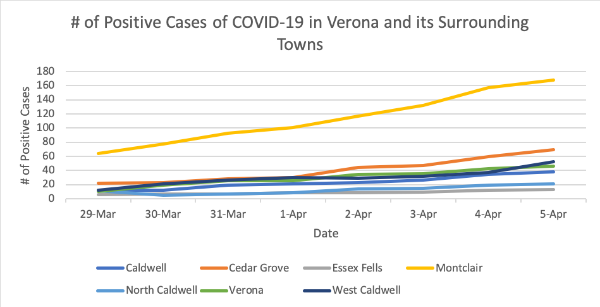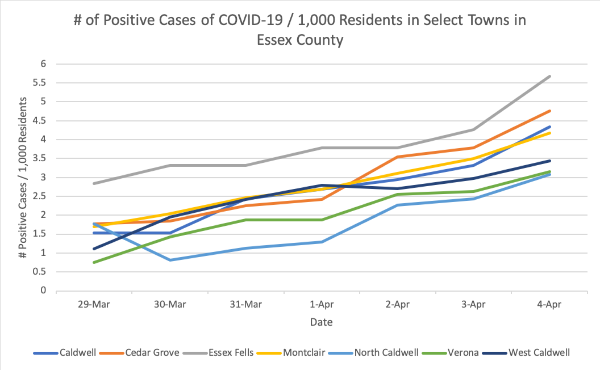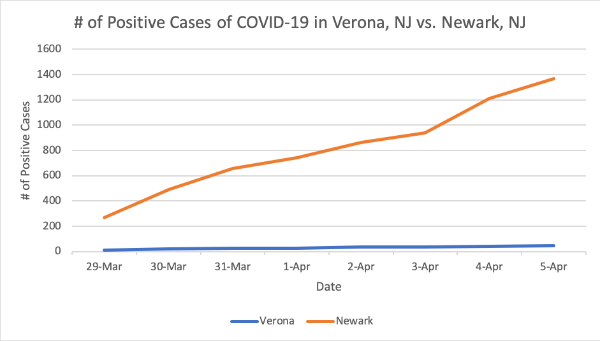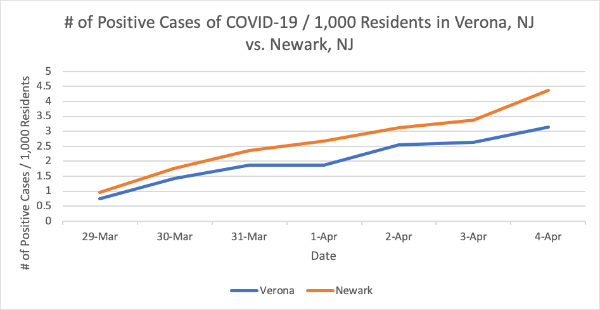 Hello and welcome to the first of a multi-week series on COVID-19 in Verona and Essex County. This report is meant to present easy-to-understand data on COVID-19 for those who are interested. I am not a doctor, nor am I a public health expert or official, and as a result cannot provide anything more than what the data say. For any questions on COVID-19, resources available, and emergency needs please refer to New Jersey’s state webpage on COVID-19, which can be found here.
Hello and welcome to the first of a multi-week series on COVID-19 in Verona and Essex County. This report is meant to present easy-to-understand data on COVID-19 for those who are interested. I am not a doctor, nor am I a public health expert or official, and as a result cannot provide anything more than what the data say. For any questions on COVID-19, resources available, and emergency needs please refer to New Jersey’s state webpage on COVID-19, which can be found here.
Before the data are presented, let me just remind everyone about a few key quick facts about COVID-19. First, COVID-19 is the official name for the virus, which belongs to the category of coronavirus. It is a respiratory illness and can be transmitted through person-to-person contact. It originated in Wuhan, China, although the virus has spread to over 174 countries as of the time of this report, per the Centers for Disease Control. It spreads mainly through person-to-person contact, but can also be transmissible through contact with infected surfaces. No vaccine or specific antiviral treatment is currently available for the treatment of COVID-19, but experts recommend social distancing of at least 6 feet and minimal contact with others to slow the spread of the virus. All of the above information was taken from the CDC’s What you need to know about coronavirus disease 2019 (COVID-19).
Now, let’s get to the data. Our data is provided to MyVeronaNJ by the Essex County Department of Health and Rehabilitation. Data comes to MyVeronaNJ as of 9 a.m. and as of 5 p.m., daily. For the purposes of these reports, MyVeronaNJ will be using data available as of 5 p.m. for the days reported on.
Looking at Figures 1 and 2, we see the number of positive cases of COVID-19 for Verona and its immediate surrounding towns expressed by number of positive cases and number of positive cases per 1,000 residents, respectively. As seen in Figure 1, the week started out with the highest number of positive cases in Montclair, which had 64 positives. The lowest number of positives was in Essex Fells which had 6. Finishing the week, Montclair still had the largest number of positive cases with 168, however Essex Fells had 13 by the end of the week, keeping it at the bottom of the surrounding municipalities. Verona consistently remained in the middle with 10 positive cases in the beginning of the week and 46 by the end.

Figure 2 shows a different picture. In terms of number of positive cases per 1,000 residents, Essex Fells was highest leading the week with approximately 2.840 positive cases per 1,000 residents and finishing the week with 6.152 positive cases per 1,000 residents. Verona had the lowest ratio in the beginning of the week with 0.750 positive cases per 1,000 residents. Finishing the week, Verona had 3.450 positive cases per 1,000 residents. Ending the week with the lowest ratio was North Caldwell with 3.396 positive cases per 1,000 residents. North Caldwell began the week with a ratio of 1.779 positive cases per 1,000 residents.

Lastly, one more important graph to look at is how Verona is stacking up against Newark, the Essex County city hit hardest by COVID-19. In Figure 3, the number of positive cases in each city is graphed, and as can be seen, Newark has a much higher cumulative number of positive cases than Verona. On March 29, Newark had 268 positive cases while Verona only had 10. On April 4, Newark had 1,210 positive cases while Verona had 42. While there exists a huge gap in the number of cumulative cases, Figure 4 shows that Newark and Verona are more evenly affected with Newark having a ratio of 0.967 positive cases per 1,000 residents on March 29 and Verona having a ratio of 0.750 positive cases per 1,000 residents. By the end of the week, Newark had a ratio of 4.936 whereas Verona had a ratio of 3.450.


A recent Time magazine article shed some light as to why low-income cities and neighborhoods are being disproportionately affected by COVID-19. Although the following are not definitive reasons for the high number of positive cases being seen in Newark, this article sheds some light onto some of the potential reasons. The article stated that many low-income families live in crowded houses and share more common spaces, which makes social distancing harder. Another reason is that these communities often do not have health insurance making preventative care such as visiting a general practitioner more unattainable, if at all possible. A big concern the article pointed out for these communities is that many who might fear they have been in contact with someone who has COVID-19 will not be able to get the proper care or know how to inquire about proper care. The concern of lack of health insurance was addressed by President Trump on Friday who announced that hospitals will be reimbursed for any costs related to treating the uninsured for COVID-19. The president hopes that these efforts will help to alleviate any concern about getting treated if someone is uninsured.
While the above numbers and graphs might appear daunting, let’s not lose sight of the good news. As of April 4, there were 2,493 tests that came back negative across all of Essex County, and hopefully we will see this number increase as more people are tested. Together, as a town and a community, we will survive this and when everything is over we will come out stronger and more resilient than ever!
Check back next Monday, April 13 for the next report covering April 5 – April 11.
Special thanks to Rich Wertz for Microsoft Excel help.
Patrick Citrano is a long-time Verona resident who graduated from Verona High School in 2016. He attends the University of Southern California, where he is studying economics and is pre-med. He will be graduating in December of 2020. Patrick has taken a variety of courses in economics, life sciences, physical sciences, statistics, public/global health, and writing. He spent his junior year assisting with global health research through USC’s Institute on Inequalities in Global Health, where he worked to better understand the legislative environment in select Sub-Saharan African countries regarding HIV healthcare and access. Last summer, Patrick interned for The Marwood Group, a consulting and advisory firm in New York, where he learned about health policy and its role in business decisions and transactions. Patrick is looking forward to what is ahead after graduation.


Well done! We will refer our patients to the article. I hope more are forthcoming. One major issue for mass testing is that positive tests need follow up with a primary care physician. Many people do not have a PCP and many PCPs are less available. The CDC recommends If you have a fever, cough and/or body aches
Stay Home
Call your Primary Care Provider for Medical Advice – CALL – DO NOT GO to a Healthcare office/facility unless directed by a medical professional.
Why? Your Primary Care Provider will best be able to evaluate you and determine the best course of action, which will keep not only you, but those around you as well as the healthcare workers safe. Your Primary Care Provider can determine whether you require COVID-19 testing and will arrange for the testing to be performed safely (often at a Drive-Up location)